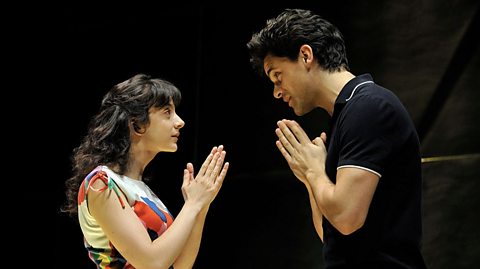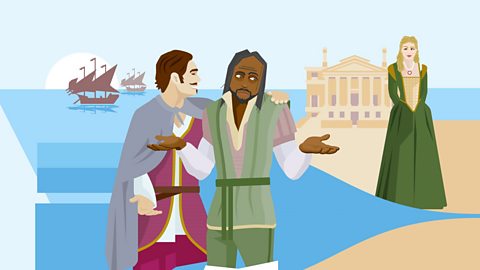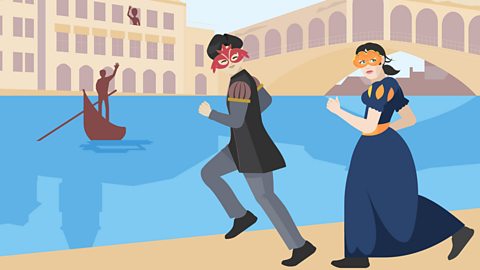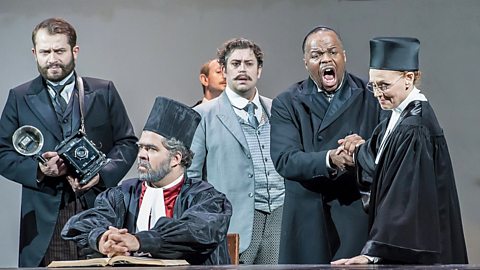What are the key themes?

The Merchant of Venice has both tragic and comic elements. So some of the themes are light-hearted, such as different types of love, and some of the themes are darker, such as prejudice and intolerance.
Some of the themes of The Merchant of Venice include:
- prejudice and intolerance
- love
- justice and mercy
- wealth


╠²╠²╠²
Remember
Shakespeare explores themes through:
- the language he uses
- the events of the play
- the way his characters behave.
You can write about all of these things when discussing the themes of the play.
Prejudice and intolerance
PrejudicePrejudice is an unfair feeling of dislike for someone because of their gender, race, religion or other feature is an unfair feeling of dislike for someone because of their gender, race, religion or other feature.
IntoleranceIntolerance is unwillingness to accept views, beliefs or behaviours that differ from your own is unwillingness to accept views, beliefs or behaviours that differ from your own.
There are two main types of prejudice and intolerance in The Merchant of Venice:
- antisemitismAntisemitism is a type of prejudice or discrimination towards Jews individually or as a group. It is based on unfounded stereotypes that target Jews as a people or their religious practices and beliefs.
- prejudice against women
Most of the main characters in The Merchant of Venice are Christians. One central character, Shylock the money lender, is Jewish.
Antisemitism

The Merchant of Venice is considered controversial because of its portrayal of antisemitism.
Antisemitism is a type of prejudice or discrimination towards Jews individually or as a group. It is based on unfounded stereotypes that target Jews as a people or their religious practices and beliefs.
The impact of antisemitism has resulted in Jewish people facing discrimination, being banished or even murdered.
Antisemitism was common in in Europe when Shakespeare wrote The Merchant of Venice. In Venice itself, Jewish people had been forced to live in a separate area of the city since 1516.
Today there are various interpretations of antisemitism in The Merchant of Venice. People cannot agree on whether the play is antisemitic or seeks to criticise antisemitic behaviour. This is one of the reasons it is sometimes described as a ÔÇ£problem playÔÇØ.

Question
How does Shakespeare show prejudice and intolerance against Shylock?
- ShakespeareÔÇÖs characterisation of Shylock
- He is portrayed as a greedy money lender, who charges interest on his loans and is seen counting his stores of money.
- He is portrayed as being mercilessly cruel. He insists on having his pound of flesh, even when Portia lectures him on the beauty and godliness of mercy. This suggests that Shylock is unforgiving and cruel.
- The way that other characters respond to Shylock
- He is racially and physically abused by Antonio. Shylock remembers how he has been called a dog, kicked and spat on in the street. Antonio does not deny these allegations and actually says he would do the same again if given the chance.
- He is denied the dignity of a name by many of the Christian characters who call him ÔÇ£JewÔÇØ, ÔÇ£The JewÔÇØ, ÔÇ£devilÔÇØ, ÔÇ£unbelieverÔÇØ and more.
- Shylock's response to discrimination
One of the main pieces of evidence that Shakespeare is challenging and criticising antisemitism can be seen in ShylockÔÇÖs powerful speech in Act 3, Scene 1 where Shylock asks for understanding and tolerance of his Jewish faith. He compares Christian and Jewish people, noting everything that they have in common.
Hath not a Jew eyes? Hath not a Jew hands, organs, dimensions, senses, affections, passions?
(Act 3, Scene I)
In this speech, Shylock is talking about how Antonio has turned friends against him and made enemies hate him even more. He says that Antonio has laughed at him and told lies about him simply because he is a Jew.
Shylock is understandably angry that he is being treated differently because of his religion. Shylock asks a number of rhetorical questions showing that Christian and Jewish people are the same in many ways.

Did you know?
Some modern-day directors choose interesting ways to highlight the antisemitismAntisemitism is a type of prejudice or discrimination towards Jews individually or as a group. It is based on unfounded stereotypes that target Jews as a people or their religious practices and beliefs. in the play.
A Royal Shakespeare Company production, re-titled ÔÇ£The Merchant of Venice 1936ÔÇØ, first premiered in 2023 and was directed by Brigid Lamour.
It transports the play to 1930s Britain where a female Shylock, first played by Tracy-Ann Oberman, is portrayed as a dignified and strong woman facing the growth of fascismA type of far-right government that first appeared in Europe in the early 1900s. Fascist countries are usually ruled by one party, led by a dictator who has all of the power. Other features of a fascism include the use of violence against political opponents, the government keeping tight control of different aspects of everyday life, racist beliefs and discrimination against minority groups. and anti-Jewish propagandaPropaganda is when words, images or films are used to try and make people think a certain way. prior to the Second World War.
Prejudice against women
Women in ShakespeareÔÇÖs time were subject to a patriarchyA social system in which men rule and hold power over women. system. This means that men held the power in society and women were excluded from positions of power. Women were not allowed to have jobs outside of the home, to choose their husband or to act on the stage.
The power of men against women is seen in two different father/daughter relationships in The Merchant of Venice:
Jessica and Shylock
Jessica is subject to the patriarchal influence of her father Shylock. She feels stifled by the rules that Shylock puts in place for her and calls her house ÔÇ£hellÔÇØ and full of ÔÇ£tediousnessAnother word for boredom.ÔÇØ.
She rejects his authority and escapes his control by running away with Lorenzo. She converts to Christianity to reject her fatherÔÇÖs influence.
Portia and her dead father
Portia is still subject to the patriarchal influence of her father after his death. She is not able to choose her own husband because her father has left a will saying that her husband will be the first person to solve the riddle of the caskets. Portia is a ÔÇ£prizeÔÇØ in her fatherÔÇÖs strange game.
Portia is unhappy about her lack of power but can only speak her mind in discussion with her lady in waiting Nerissa.
Later in the play, Portia can only show intelligence and be taken seriously by disguising herself as a man at the trial of Antonio. PortiaÔÇÖs winning argument at the trial would not have been heard if she had appeared as a woman.

Did you know?
It is common for female characters in Shakespeare plays to disguise themselves as men. In The Merchant of Venice Jessica disguises herself as a young man to escape with Lorenzo. Portia and Nerissa disguise themselves as male lawyers.
In ShakespeareÔÇÖs time, the parts of Jessica and Portia would be played by young men because women were not allowed to act on stage. ShakespeareÔÇÖs contemporary audiences would find it funny to see a young man, playing a woman, disguising herself as a man.
Question
Is The Merchant of Venice antisemitic?
Some people consider the play to be antisemitic because of the way that Shylock is portrayed as a greedy moneylender and the abuse that he receives.
Other people think that Shakespeare was trying to shine a light on antisemitism and show the cruelty of the Christian characters in the play, especially as Shakespeare gives Shylock speeches in which he explains his humanity and talks about the cruelty he has endured.
Love
Romantic love

Romantic love is a common theme in ShakespeareÔÇÖs comedies.
The main romantic relationship in the play is between Bassanio and Portia. They have a strong and genuine love for each other.
Other romantic relationships in the play include:
Jessica and Lorenzo who run away from Shylock to marry
Gratiano and Nerissa who are both involved in the comedy plot involving the missing wedding rings at the end of the play.

Question
What do these quotations show about Portia and Bassanio's love?
Friendship

There are a number of friendships portrayed in The Merchant of Venice. The strongest of these is between Antonio and Bassanio. This friendship is the basis of the bloodthirstyCruel and barbaric. bargain with Shylock at the start of the play and it propels the plot forward.
BassanioÔÇÖs loyalty to Antonio shows him to be a good friend. In fact, audiences might question whether Bassanio values his relationship with Antonio above his relationship with his wife. When Bassanio hears that Antonio has been arrested, he rushes to see Antonio at trial to support him.
He does not realise that Portia is in the court room, disguised as a lawyer. Portia overhears Bassanio say that he would sacrifice his life with his wife to save Antonio.
Portia, disguised as the lawyer responds with:
Your wife would give you little thanks for that
if she were by.
Some productions also choose to suggest that Antonio and Bassanio are romantically or sexually attracted to each other. In such productions, AntonioÔÇÖs sadness at the start of the play is explained by his feelings for Bassanio.

Family love

The main family relationships shown in the play are between fathers and daughters.
Portia loved her dead father but her feelings for him are complicated because he has not allowed her to choose her own husband.
Patriarchal father/daughter relationships are mirrored in the relationship between Shylock and Jessica. Jessica cannot choose a Christian man to marry, and is forced to run away with him.
Shylock's love for his daughter and sadness at her loss is muddled up with his sadness over the loss of a ring given to him by his dead wife and Jessica running away with a Christian.

Mini quiz
Justice and mercy
The play features a courtroom drama in Act 4 and questions of justice and mercy are central to the plot.
In court, Shylock is focused on justice, whereas Portia values mercy. Shylock and PortiaÔÇÖs contrasting ideas about justice and mercy create the dramatic tension in the courtroom trial scene.

Shylock's view of justice
Shakespeare portrays ShylockÔÇÖs idea of justice as a desire for revenge. Shylock says to Antonio:
The villainy you will teach me
I will execute.
In other words, his justice is based on payback - he wants to get even for his bad treatment over the years. Cutting away a piece of AntonioÔÇÖs flesh is a way of getting his retribution for the terrible antisemitismAntisemitism is a type of prejudice or discrimination towards Jews individually or as a group. It is based on unfounded stereotypes that target Jews as a people or their religious practices and beliefs. he has suffered.
Portia's appeal for mercy
In her powerful speech, Portia talks of the importance of mercy. She believes that mercy is kingly and godly. It is gentle and powerful, and allows for forgiveness and understanding. She says:
'Tis mightiest in the mightiest; it becomes
The throned monarch better than his crown.
Portia is recalling the teachings of the New Testament of the Christian Bible, where Jesus encouraged his disciples to practise forgiveness and turn the other cheek when wrong was done to them. She appeals to Shylock to show mercy to Antonio.
Context ÔÇô Conversion to Christianity

Modern audiences might be confused about the behaviour of the Christian characters at the end of the trial.
Shylock is forced to give up the religion he loves and convert to Christianity. Some audience members might think that this is cruel, intolerant and vengeful behaviour.
However, Christians in 16th Century England may have seen the Duke's decision that Shylock convert to Christianity as merciful.
Audiences in the16th century may have felt that conversion to Christianity would save Shylock from hell and give him a chance of redemption in the eyes of Jesus.
Question
What simile does Portia use to describe mercy?
Answer
Portia compares mercy to gentle rain. The rain drops from heaven, showing us that mercy is a Godly quality. Portia argues that to be merciful and forgiving brings people closer to God. Even kings should be merciful because mercy suits a king more than his robes and crown.
Wealth

The theme of wealth is explored in many ways in The Merchant of Venice. It can see seen as both a positive and negative force.
Antonio is very wealthy at the start of the play but he is also suffering from an unexplained sadness. AntonioÔÇÖs wealth does not buy him the happiness he desires
AntonioÔÇÖs wealth allows him to support his friendsÔÇÖ ventures, such as BassanioÔÇÖs desire to visit Portia in Belmont
Wealth can be misleading. Most of PortiaÔÇÖs potential husbands assume that the gold casket is the one that holds the prize of her hand in marriage because they incorrectly think that the casket which is worth the most money worth will hold the prize. When one of PortiaÔÇÖs suitors realises his mistake, he says:
All that glisters is not gold.
- There are various examples in the play of Shylock being mocked for his greed and his love of money. Solario and Solanio make fun of ShylockÔÇÿs love of money. ShylockÔÇÖs wealth is criticised by some of the Christian characters in the play as a product of usuryLending money to people at high interest rates..

Mini quiz
Context ÔÇô Venice as a trading location

In Shakespeare's time, Venice was an important trading location and some British traders would have had dealings with Venetian traders.
There were few Jews in Shakespearean England, but there were Jewish communities in Venice where the play is set.
Charging interest on loans was permitted in the Jewish community, but frowned upon in the Christian community. This is important to the plot and the prejudicial views of the Christians in the story, who criticise Shylock for charging interest on loans.
Quiz
Test your knowledge of the themes of ShakespeareÔÇÖs Merchant of Venice by taking this multiple-choice quiz.
More on The Merchant of Venice
Find out more by working through a topic
- count1 of 5
